I’ve done the math: I’ve spent more hours in my career as a digital project manager staring at a blank screen trying to think of annual performance goals than I have spent actually discussing those goals at a performance review.
Likewise, I’ve spent about the same amount of time throughout my time as a career manager helping my project managers sculpt somewhat nebulous goals into actionable, meaningful, and measurable statements.
Why is it so hard for us to put into words the things that we would probably do anyway if left to our own devices?
I certainly don’t have all the answers—I am, after all, but a mere mortal digital PM and people manager who still loathes annual performance goal setting.
And, sure, there are a whole bunch of other articles about goal-setting that you could read. My colleagues have even written a great article on setting goals and achieving them.
But one thing that I think they all are guilty of doing is obfuscating the creative process behind goal-setting. The writing and rewriting. The tension and the torment. The push-pull of feeling motivated while also feeling devastatingly inadequate.
What Are Annual Performance Goals For Anyway?
Most people misunderstand annual performance goals. They think they are individual goals that exist in a vacuum. But in reality, the purpose of setting annual performance goals is to align the energy you spend within a team or organization to the goals and objectives of that team or organization.
Read that again. These goals aren’t even really about you. Not entirely, at least.
Who Still Does Annual Performance Reviews, And Should They?
Okay, so maybe you got this far and you’re asking: who still does annual performance reviews? And you’d be right to say that there is a shift towards more regular performance check-ins as well as models where there’s no performance review at all.
But I think that makes what I’m about to talk about even more important: it’s still a great idea to create goals iteratively, revisit them with your manager, and keep ensuring that everyone’s compass is pointing where we expect it to be pointing.
Why Do So Many Project Managers Hate Setting Annual Performance Goals?
I suspect that our collective hatred of setting annual performance goals has some relationship with why people find it so much easier to set new year’s resolutions.
With new year’s resolutions, it’s almost understood that you’ll break at least some of them. On the other hand, annual performance goals are shared with your boss and maybe even your boss’ boss. And you are held accountable to them. And it feels hard to change them. And you never have a crystal ball. It’s like trying to hit a bullet with a smaller bullet whilst wearing a blindfold, riding a horse (thanks to Simon Pegg as Scotty from Star Trek for the metaphor).
3 Simple Tips For Iterating Through The Process Of Creating Annual Performance Goals
The thing is, people can tell you to create SMART goals until they’re blue in the face, but that doesn’t necessarily make the process of creating them easier. What it can do is make the process of creating them more iterative.
Here are my top 3 tips for approaching annual performance goals iteratively:
1. Don’t Wait Until The End Of The Year
Seems obvious, right? Don’t leave it to the last minute. But this is actually really difficult to do in practice without being deliberate about it and having a system.
One method I’m fond of is keeping a notebook (analog or digital) of wins and goals that I add to as they come up. That way I’m iteratively building the rough draft of my performance review strategy.
And that saves me boatloads of time otherwise spent trying to remember things that happened 11 months ago!
2. Focus On Value
As I mentioned earlier, these goals are sort of mostly kinda somehow not really about you at all. It’s about the value you deliver to help your team or organization achieve their goals. That’s the value exchange that is our professional lives, whether you like it or not!
So, yes, first write them about yourself as if you existed in a vacuum. But also make sure you’re plugged into where the company is headed. Think of how your leadership team will be measured. Consider how your team will need to develop to hit the big strategic objectives.
Then iterate on your personal goals using that lens to pair your ambition with your company’s direction and culture. Sure, you can have a goal that you want to do a blockchain project, but if that’s not where your employer’s appetite is, your goals will be at odds with the broader organization.
3. Create Them As A Conversation
Guess what: even after you iterate on your goals and are ready to present them, your manager will probably still propose changes and tweaks.
That’s because they will be thinking of it from the perspective of whether you achieving your goals also aligns with how they are able to achieve their goals (and so on and so forth up the chain—we’ll get to that in the next part of this series!).
So use them as a communication tool that facilitates that meeting of minds that will invariably need to happen. That in itself is an iteration!
A Few Example Goal Iterations For (Digital) Project Managers
Okay, but what does this look like in practice? And can’t I just give you a time-saving shortcut already? Yes, I can! But be advised that every organization is different, that goals are very personal things, and that not all digital PMs will have the same goals.
From the years I’ve spent struggling with annual performance goals, I find there are four key categories that I always return to:
- Mastering Core Competencies
- Stretching Into That Next Role
- Learning Something New
- Finding Better Ways Of Doing Things
Let’s dive into a few examples:
Mastering The Core Competencies Of Your Current Role
This is about ticking all the boxes of what someone in your role should be aspiring to excel at. But I don’t mean the table-stakes version! Don’t put things like “deliver the e-commerce project on-time and on-budget”. Dig into the “how” and the “why”, and then SMART-ify them.
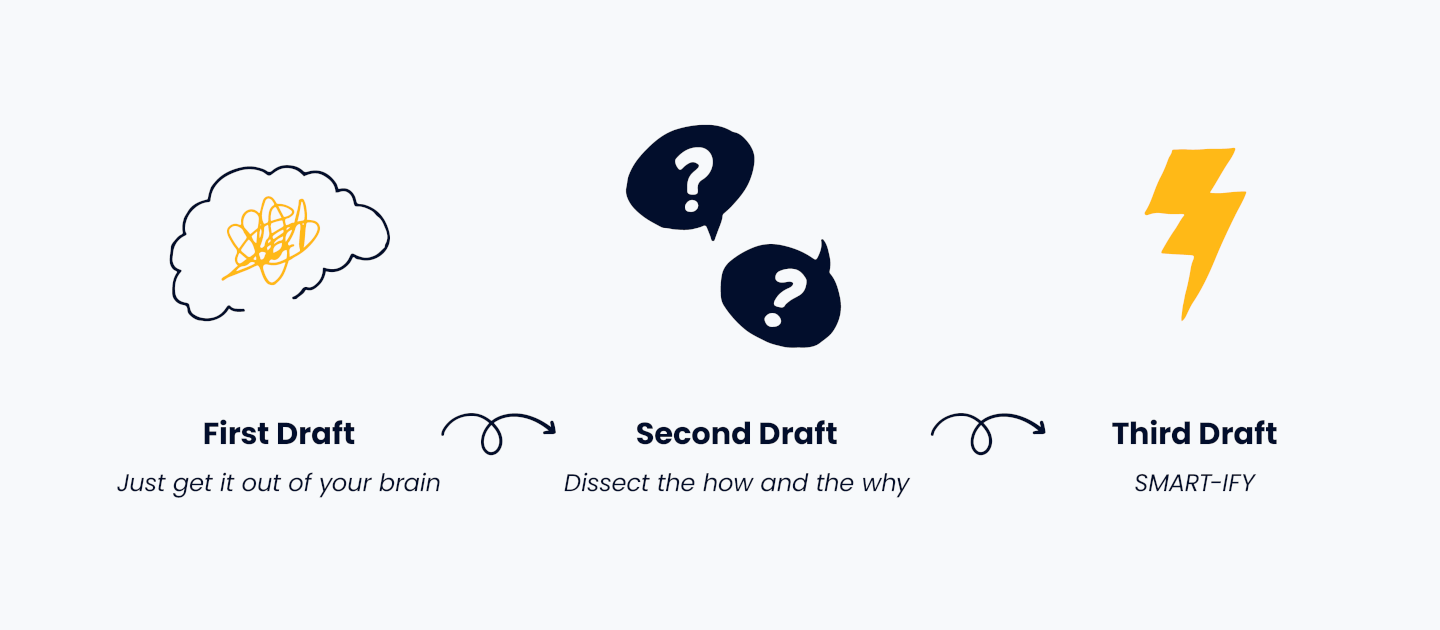
Goal-setting is an iterative process.
Example 1
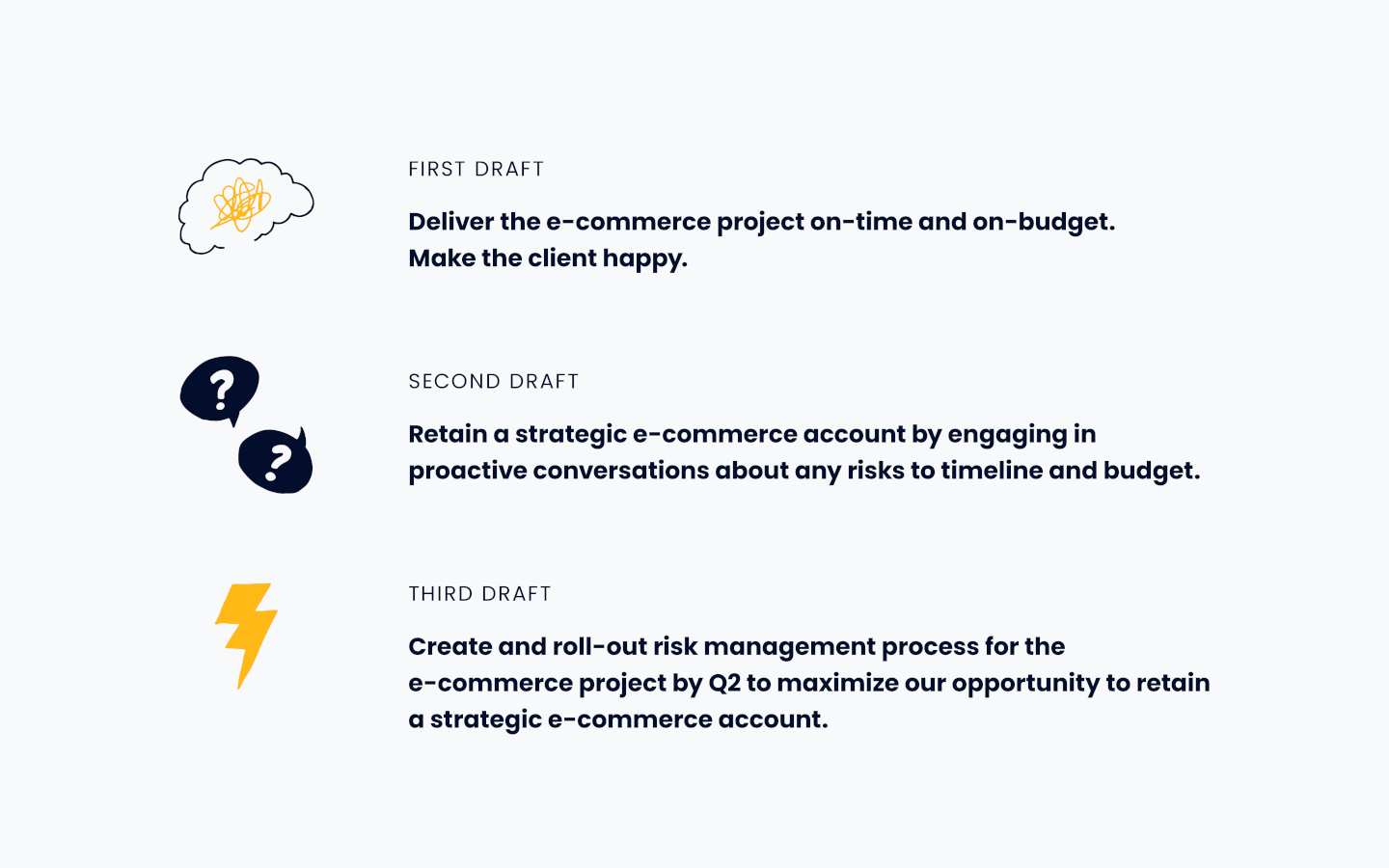
Our mastering core competencies example.
First draft: just get it out of your brain
“Deliver the e-commerce project on-time and on-budget. Make the client happy.”
Second draft: dissect the “how” and the “why”
“Retain a strategic e-commerce account by engaging in proactive conversations about any risks to timeline and budget.”
Third draft: SMART-IFY
“Create and roll-out risk management process for the e-commerce project by Q2 to maximize our opportunity to retain a strategic e-commerce account.”
Stretching Into The Core Competencies Of That Next Role
This is more about your career trajectory and where you want to go within the organization. It’s plotting a course to your next promotion. These are skills you want to build and experience you want to acquire that will also add value to your team and your organization.
Related Read: What Is A Project Manager Portfolio? (+ Examples & Template)
Example 2
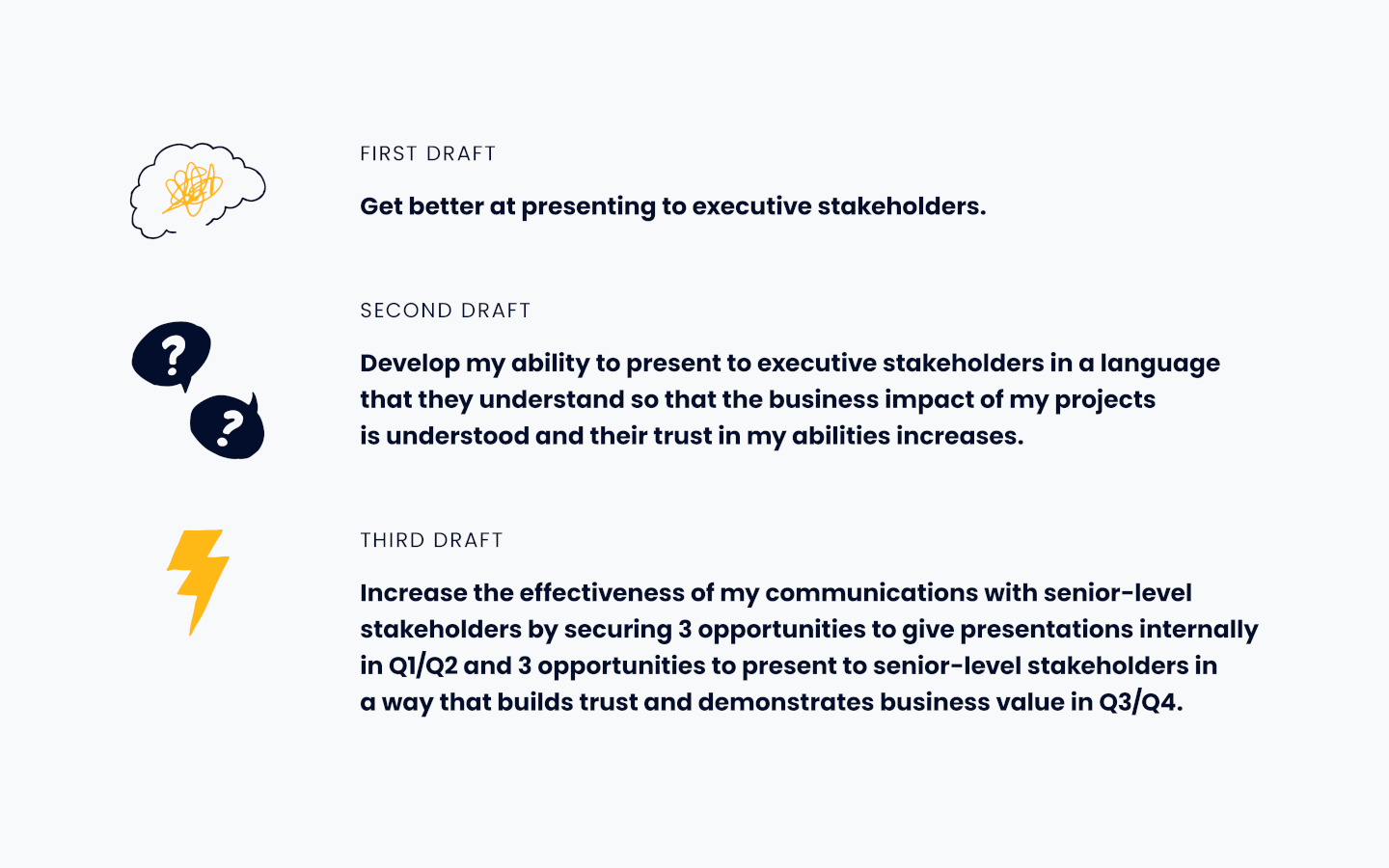
An example of iterative goal setting for stretching into core competencies.
First draft: just get it out of your brain
“Get better at presenting to executive stakeholders.”
Second draft: dissect the “how” and the “why”
“Develop my ability to present to executive stakeholders in a language that they understand so that the business impact of my projects is understood and their trust in my abilities increases.”
Third draft: SMART-IFY
“Increase the effectiveness of my communications with senior-level stakeholders by securing 3 opportunities to give presentations internally in Q1/Q2 and 3 opportunities to present to senior-level stakeholders in a way that builds trust and demonstrates business value in Q3/Q4.”
Learning Something New
This is about developing new skills and becoming more T-shaped. It may not have to do with your current role and responsibilities, and it may not be part of your next role’s job description, but it’s something that will give you lateral and ancillary skills that deliver value to your team or your organization.
Example 3
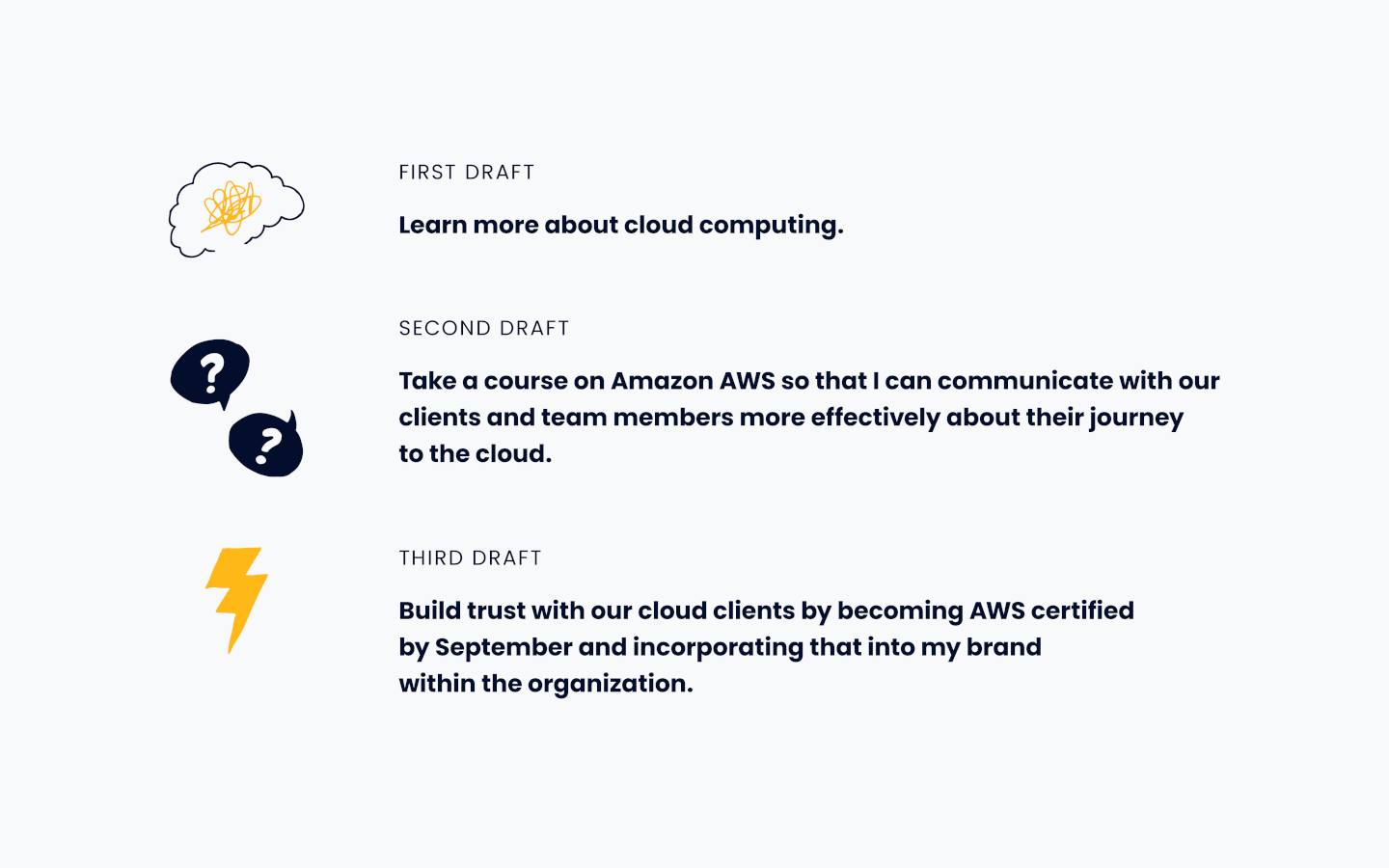
Our example for learning something new.
First draft: just get it out of your brain
“Learn more about cloud computing.”
Second draft: dissect the “how” and the “why”
“Take a course on Amazon AWS so that I can communicate with our clients and team members more effectively about their journey to the cloud.”
Third draft: SMART-IFY
“Build trust with our cloud clients by becoming AWS certified by September and incorporating that into my brand within the organization.”
Finding Better Ways Of Doing Things
These are more about process improvements and productivity. They might start as personal goals, but they should radiate outward to show potential impact on the way the business is run.
Example 4
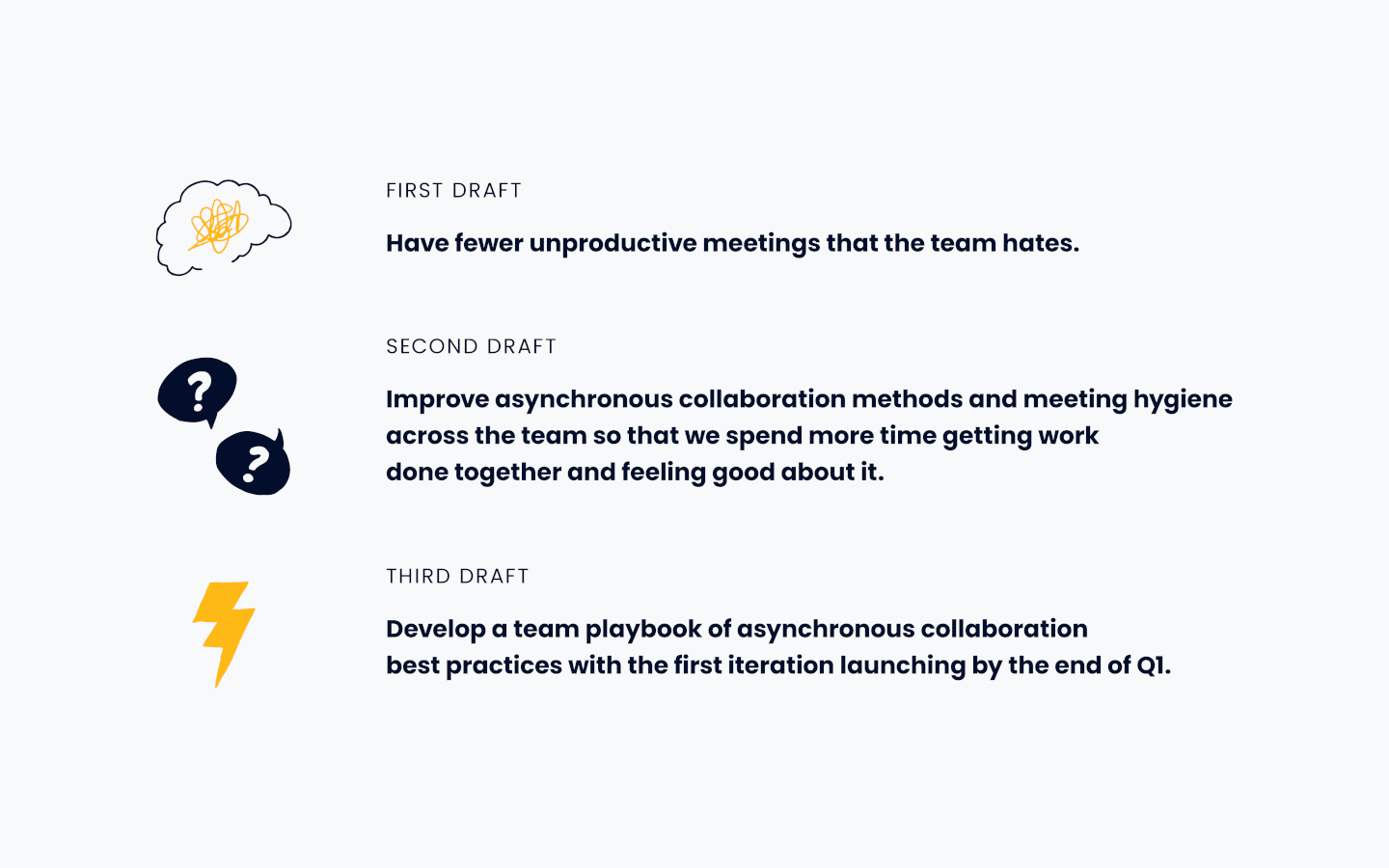
An example for finding better ways of doing things.
First draft: just get it out of your brain
“Have fewer unproductive meetings that the team hates”
Second draft: dissect the “how” and the “why”
“Improve asynchronous collaboration methods and meeting hygiene across the team so that we spend more time getting work done together and feeling good about it.”
Third draft: SMART-IFY
“Develop a team playbook of asynchronous collaboration best practices with the first iteration launching by the end of Q1.”
What’s Your Take?
So what do you think? Have I painted a clearer picture of the creative process behind goal-setting and how an iterative approach can make your life a tad bit easier? Let me know in the comments!
Also, I wanted to mention that this is just part one of a series. In the next part, we’ll teach you how to infuse storytelling into your goals so that it’s easier to share up the chain in a larger and more layered organization, and ultimately so that you get what you want from your career.
Oh, and by the way, we’re sharing tips like this all the time within our members’ community and our weekly newsletter. To stay in touch and have insights like this to chew on week-over-week, subscribe.


